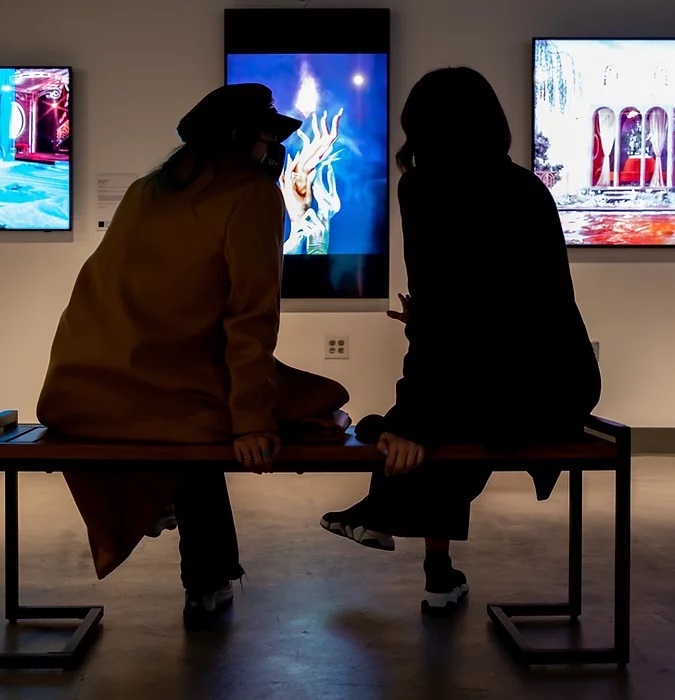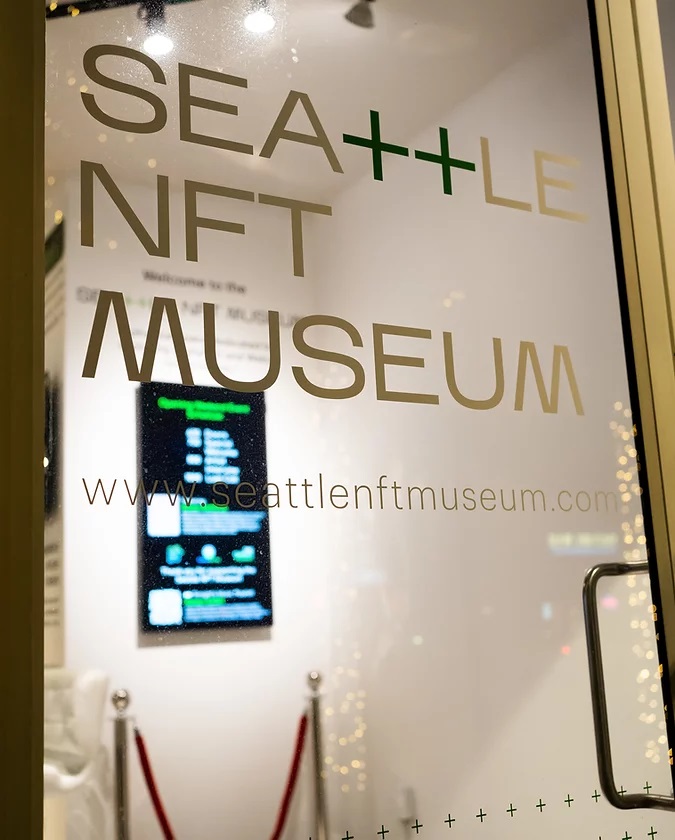Seattle NFT Museum (SNFTM) has held its opening weekend on January 14th and 15th 2022 and will open to the public on January 27th 2022.
As described in its official website, SNFTM was designed to ‘bring together artists, creators, collectors, and the broader blockchain community’. The museum aims to educate the public about the NFT arts. Jennifer Wong and Peter Hamilton-the founders of Seattle NFT Museum, told Seattle Times, they would like to bring context to the art pieces, so they really focus on more of the museum aspect, than just a gallery. This space is not a sales space, but rather an educational and social space to display the collection of NFT arts.

Courtesy of Seattle NFT Museum. https://www.seattlenftmuseum.com/
This museum pushes the boundaries between the virtual and the physical. Displaying digital artworks in physical space has its own challenge. Seattle NFT Museum overcome this challenge by partnering with Samsung to display vivid color and perpetual motion of digital works. From 85” to 32” crystal clear window, across portrait and landscape orientation the viewer will experience an immersive art journey. Every installation also has a link to the metadata and artist story, to help the viewer to discover an interesting thing in each work.
The mission of this museum is to ‘create a physical connection directly to the authentic digital assets’. The founders hope their Belltown space can provide a more tactile interaction of digital arts. This space also gives an appreciation for digital arts, that before the NFTs, it was underrepresented and underappreciated as ‘right-click-save-as’ artwork. Told Travel + Leisure, the founders want to bring some more notoriety to digital arts and artists by providing information about their medium, their practice, and their inspiration.
Courtesy of Seattle NFT Museum. https://www.seattlenftmuseum.com/
Currently, Seattle NFT Museum highlights the works of Blake Kathryn, Larva Lab’s CryptoPunks, H+ Creative, and Seattle-based artists, such as Neon Saltwater, Charles Peterson, and Robbie Trevino. The works on view have a wide range of variety from Blake Kathryn’s and H+ Creative artists’ 3D virtual environments and figures, Larva Lab’s Punks avatar, Neon Saltwater’s mysterious virtual rooms, Charles Peterson’s photographs of 1990s live shows bands including Nirvana, to Robbie Trevino’s surreal and sci-fiction illustration.
The Seattle NFT Museum is located at 2125 1st AVE in Seattle, WA.
Digital art is a Genuine art
Up to now, some people are still questioning the status of digital art as ‘art’. Personally, I agree with the mission of The Seattle NFT Museum to appreciate digital art and artist. ‘Digital art is a genuine art’. I adapt this disposition from David Chalmers’s statement ‘Virtual Reality is Genuine Reality”.
Quoted from his interview with The Guardian, he argues that ‘technology reaching the point where the virtual and physical are sensorily the same and people can live good lives in VR’, just like in our ordinary physical world. In digital arts, like in other physical arts, the viewer still can enjoy the aesthetic experience, through their exposure to colors, lines, movement, lights, and contents.
Indeed, the material of digital images is different from analog images. A digital image consists of finite numbers of pixels that determine the quality of a represented image. However, following W.J.T. Mitchell’s argument in his essay ‘Realism and The Digital Image’, the difference between the analog and digital image is not a ‘rigid binary opposition’, but rather ‘flexible difference’.
The digital image can be perceived, scanned, mapped, depicted, described, and assessed as we do it in analog format (Mitchell, 2015: 57). Representing an image in pixels is also not something new. It reminds us of Ben-Day dots to inexpensively produce an image using close small dots, pointillist painting, and even long before that, Australian Aboriginal artists have used small dots to create a painting. We perceive digital image not pixel by pixel, but in its united colors and forms, similarly in an analog image. In fact, there is no difference between perceiving digital and analog images. The digital image can also bring art experience, not inferior to the analog image. Thus, digital art is genuine art.

